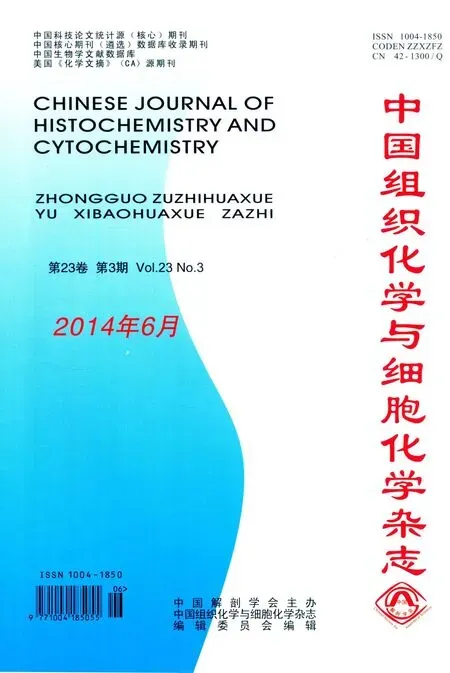光周期影响MT1-R在无蹼壁虎室旁核的节律性表达
赵劲松 汪安云 文育锋 鲁亚平
(1皖南医学院,芜湖241000;2安徽师范大学生命科学学院,芜湖241000)
Introduction
Themajority of mammalian behaviors and physiological phenomenon,such as awakens,the breath,the body temperature,the immunity,the nerve endocrine activity and the cell division and so on,have the endogenous circadian periodicity,these is the compatible characteristic preserved in the natural selection and the long-term evolution process.But these rhythms generally may(mainly be photoperiod)change along with the external environment,when the organism is shined by the light,the biological clock system entrains and promotes chain reaction magnification process from light signal to nerve endocrine signal,thus regulates the behavior and physiological activity of organism in a large scale scopes,therefore the photoperiod becomes “the main trigger”of endogenous circadian rhythm in many mammal.In the reptile,the physiological rhythm may be triggered by the combination of pineal gland,SCN,and retina,but there is no coincident view about which is the most important among the third.The melatonin is a nerve endocrine hormone secreted by pineal gland at night.The experiment on the animal in recent years confirmed that,as a multi-functional photoperiod signal,the melatonin has important physiological functions in the regulation of circadian rhythm[1];In addition,the melatonin also plays an important role in the process of sexual maturity,reproduction,anti-tumor,anti-oxidation and so on[2].The comprehensive biological effect of Mel is mainly mediated by its receptor[3],which is a type of high affinity,G-protein coupling receptor[4].
In recent years,with the immunohistochemistry technology,the nucleic acid hybridization technology,the virus tracing nerve tract technology being used in the discussion on the rhythm,the studies on biological clock system progress by leap and bounds.In this article,we study circadian rhythm expression and seasonal rhythm expression of the melatonin specific receptor(MT1-R)in the paraventricular nucleus of Gecko Swinhonis in the different seasons(The rhythm of is changed by the metabolism of amino acid decomposition and synthesis),and present the material for the further studies of the mechanism of the interaction between the Mel and its receptor’s rhythmic expres-sion,and the various functions of the MT1-R in the PVN of Gecko Swinhonis.
2 Material and method
2.1 Materials
Female and male adult of Gecko Swinhonis(span 110-120mm),purchased from Jiuding mountain special animal cultivation company of Ji-nan city,Shandong Province,are fed with bread worm in the laboratory,water and food freely get.The first batch of Gecko Swinhonis was purchased in December,2004.According to different photoperiod(Dark-Dark,DD;Dark -Light,DL 15h:9h;Light-Light,LL),we divide the Gecko Swinhonis into three groups(light intensity is 900Lx,red intensity is 10 ~15Lx when operated in the dark),each group of 36.The ambient temperature is 12±3 ℃for all the three groups.After staying in the processing environment for two weeks,picking out six Gecko Swinhonis from the three groups respectively in CT7,CT11,CT15,CT19,CT23,CT3,beheading and taking out of the brain immediately,and rapidly fixes to the new confecting 4%paraformaldehyde phosphoric acid buffer(PB pH 7.4),after the night the gradient dehydration of alcohol,the conventional paraffin wax embeds.In July,2005,second batch of Gecko Swinhonis are puechased,similarly photoperiod differently divides into the Gecko Swinhonis basis three groups(DD;DL 10h:14h;LL),each group of 36,locate the ambient temperature to maintain at 20±3℃.The paraffin wax embedding brain organization and makes the continual coronal slice,thick 6um,pasted to spreads has gathers the lysine to carry sheet glass on.For the localization,the hematein dyeing demonstrates the histology structure of brain.
2.2 Immunity blotting examination antibody specificity
Glass homogenizer(2ml,sets at on ice)to join 1ml TBS(pH7.4)+10ul protein inhibitor,the entire brain puts in homogenizer;Homogenous mixture centrifugate 10minutes,12,000g;Leans-on is clear,surplus sets at on the ice 10minutes,under similar condition centrifugate 20minutes.The protein analysis uses the method of Bradford.[5]
2.3Immunohistochemistry Method
Immunohistochemiscal method as mentioned before.[6]
2.4Observations and the statistical analysis
After dyeing,the slice with biology microscope Nikon under the E800uis observed.Separately in the low power objective (4×),media power objective of mirror(10×),under high power objective (40×)carries on to the dyeing slice photographs.The organizational structure and the nuclear group name refers to Sternberger’s report(1974)[7].Using Metamorph biology image analysis software (Universal Imaging Corp.US)and the automatic motion platform,quantitative analysis relates to morphology parameter,the man-power counts the positive-cell number.The obtained data uses SAS statistics software processing.All results use"the mean value±standard error"the expression,difference of various time spot with one-way analysis of variance(ANOVA),seasonal difference of the same photoperiod with t-test.In either case,the significance is considered at the P<0.0001level.
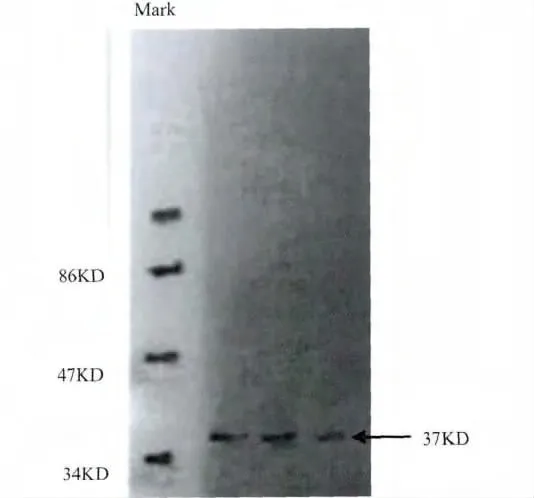
Fig.1 MT1-R protein molecular weight is 37KD
3 results
3.1 Western blotting
Western blotting result shows,MT1-R protein band in Marker protein between 34KD and 47KD strip band,thus irrevocably proved the MT1-Rprotein molecular weight is 37KD,therefore our immunohistochemistry result is credible.(See figure 1)
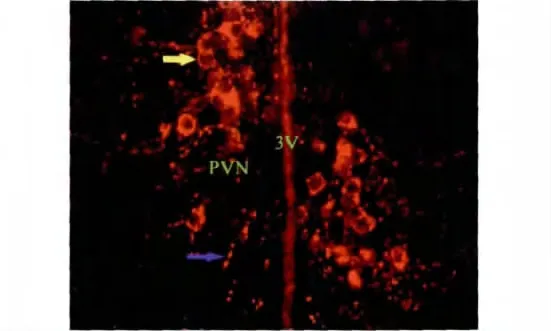
Fig.2 Distribution of MT1-R positive cells in the PVN of hypothalamus.(×400)Yellow arrow means distribution of MT1-R positive cells in the PVN.Blue arrow means distribution of MT1-R positive fibers in the PVN.3V,Third ventricle;PVN,the paraventricular nucleus

Fig.3 Under the condition of DD,MT1-R shows seasonal rhythm
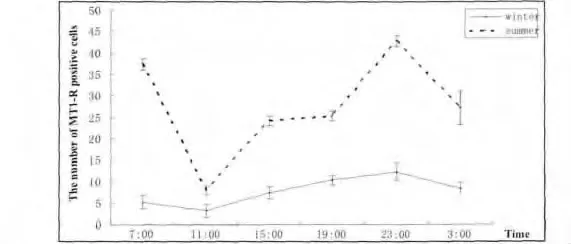
Fig.4 Under the condition of LL,MT1-R shows seasonal rhythm
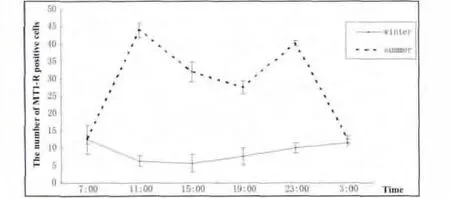
Fig.5 Under the condition of DL,MT1-R shows seasonal rhythm
3.2 Distribution of MT1-R positive reaction in the PVN
Immunohistchemiscal result showed,the MT1-R receptor immunity positive reaction mainly distributes to the PVN.In addition,the lateral area of hypothalamus and nucleus of the posterior pallial commissure also has the minority distribution[8].(See figure 2)
3.3 Circadian rhythm expression of MT1-R positive cells in the PVN

Table 1 Number of MT1-R positive cells circadian rhythm expression in summer and winter
3.3.1 Circadian rhythm expression of MT1-R positive cells in summer

Table 2 Number of MT1-R positive cells seasonal rhythm expression in summer and winter
Under the condition of DL photoperiod,the number of MT1-R immunoreaction cell has undulated:CT7-CT11rises,CT11-CT19drops,CT19-CT23rises,CT23-CT7drops,presents the obvious circadian rhythm change(ANOVA,P<0.0001).The peak value is located CT11,the valley value is located CT7.(See table 1)
Under the condition of DD photoperiod,the number of MT1-R immunoreaction cell has undulated:CT7-CT11drops,CT11-CT19rises,CT19-CT23drops,CT23-CT3rises,CT3-CT7drops,presents the obvious circadian rhythm change(ANOVA,P<0.0001).The peak value is located CT19,the valley value is located CT23.The num-ber of MT1-R immunoreaction cell occur a timephase shift of retarding for 8hours comparing with DL photoperiod.(See table 1)The number of MT1-R positive cells in DD more than in DL,there was significant difference(P<0.0001).(See table 2)
Under the condition of LL photoperiod,the number of MT1-R immunoreaction cell has undulated:CT7-CT11drops,CT11-CT23rises,CT23-CT3drops,CT3-CT7rises,presents the obvious circadian rhythm change(ANOVA,P<0.0001).The peak value is located CT23,the valley value is located CT11.The number of MT1-R immunoreaction cell occur a time-phase shift,comparing with DL photoperiod,the peak level retards for 12 hours,the lowest level retards for 4hours.(See table 1)The number of MT1-R positive cells in LL than in DL,there was not significant difference.(See table 2)
3.3.2 Circadian rhythm expression of MT1-R positive cells in winter
Under the condition of DL photoperiod,the number of MT1-R immunoreaction cell has undulated:CT7-CT15drops,CT15-CT 7rises,presents the unobvious circadian rhythm change(ANOVA,p=0.005).The peak value is located CT7,the valley value is located CT 15.(See table 1)
Under the condition of DD photoperiod,the number of MT1-R immunoreaction cell has undulated:CT7-CT19rises,CT19-CT23drops,CT23-CT3rises,CT3-CT7drops,presents the obvious diurnal rhythm change(ANOVA,P <0.0001).The peak value is located CT19,the valley value is located CT23.The number of MT1-R positive reaction cell occur a time-phase shift,comparing with DL photoperiod,the peak level is retards for 12 hours,the lowest level retards for 8hours.(See table 1)The number of MT1-R positive cells in DD less than in DL,there was not significant difference(p =0.3572).(See table 2)
Under the condition of LL photoperiod,the number of MT1-R immunoreaction cell has undulated:CT7-CT11drops,CT11-CT23rises,CT23-CT7drops,presents the obvious circadian rhythm change(ANOVA,P<0.0001).The peak value is located CT23,the valley value is located CT11.The number of MT1-R immunoreaction cell occur a time-phase shift,comparing with DL photoperiod,the peak level is retards for 16hours,the lowest level ahead for 4hours.(See table 1)The number of MT1-R positive cells in LL less than in DL,there was not significant difference(p =0.3572).(See table 2)
3.4Seasonal rhythm expression of MT1-R in the PVN of Gecko Swinhonis
The Gecko Swinhonis in the DD photoperiods,winter and summer MT1-R immunoreactivity cells exist obvious changes in circadian rhythms.At each time point in the summer of immunoreactive cell number was significantly more in winter(See table 1),both sides of the waveform are consistent with changes in summer and winter.Analysis on two seasons of winter and summer by t-test analysis shows significant difference between the two groups(P<0.0001).Therefore the Gecko Swinhonis in the DD photoperiods,winter and summer MT1-R immunoreactive cell numbers have obvious seasonal rhythm (See figure 3).
The Gecko Swinhonis in the LL photoperiods,winter and summer MT1-R immunoreactivity cells exist obvious changes in circadian rhythms.At each time point the number of immunoreactive cell in summer is more than that in winter (See table 1).In addition to CT11,the number of MT1-R positive cells in other time points have significant difference (P <0.0001).Therefore the Gecko Swinhonis in the LL photoperiods,winter and summer MT1-R immunoreactive cell numbers have seasonal rhythm .(See figure 4)
The Gecko Swinhonis in the DL photoperiods,winter and summer MT1-R immunoreactivity cells exist changes in circadian rhythms.There is no much difference between the number of CT7 ,MT1-R positive cells in summer and those in winter.(p=1.0000).(See table 1)In addition to CT3 and CT7,the number of MT1-R positive cells in other time points have significant difference (P<0.0001).Therefore the Gecko Swinhonis in the LL photoperiods,winter and summer MT1-R immunoreactive cell numbers have seasonal rhythm (See figure 5).
4 Discussion
Melatoninvia its specific receptors performs a variety of physiological functions,and its secretion peak in the night,a night of high and low of the circadian rhythm,so its receptors are rhythmic.Agez[9]study found that in the pituitary pars tuberalis of melatonin receptor also showed significant circadian rhythm,and rhythm of plasma melatonin induced directly by,the rhythm in DD interference still exists;but in the suprachiasmatic nucleus(SCN)of melatonin receptor without a circadian rhythm,show that SCN site by photoperiodic influence of melatonin receptor.Our results show that,the dormant period(winter)the number of MT1-R positive cells is less than DL,DD,LL than DL less,no significant difference(F=1.04,p=0.3572);during active period(summer)the number of positive cells of MT1-R,DD is more than DL,LL was less than DL,there was significant difference(F=10.88,P<0.0001);various conditions the number of MT1-R positive cells shows a marked circadian rhythms.The above results and Gauer in pituitary pars tuberalis of research results are compatible;but instead of the SCN results there are differences,differences may be associated with the nuclei of differentiation.
DL photoperiodshave influence on expression of MT1-R mRNA in SCN,the results shows that MT1-R mRNA in SCN presents obvious circadian rhythms,and increase significantly in daytime.[10]The results shows that DL and DD environment of MT1-R in mouse SCN have obvious circadian rhythms[11],and we are in the PVN results.In addition,MT1-R and MT2-R in the retina also have significant circadian rhythms,and the peak value appears in the night,the same plasma melatonin peak consistency,prompting in the retina of MT1-R ligands and receptors may be common coordinate secretion expression.[12]The experimental results show that,in the dormant period,active period and different period,the number of positive cells of MT1-R peak 5appears in the night(6in total),suggesting that light can influence the number of MT1-R positive cells in the peak value.That melatonin medium SCN neurons circadian phase advance in vivo,respectively by MT1-R and MT2-R mediated by melatonin on MT1-R,with inhibition,and this inhibition may be mRNA level regulation.[13]Because the melatonin concentration in vivo for night high and low,while its receptor MT1-R mRNA expression in contrast,illumination can up-regulate MT1-R mRNA expression,illumination and 1hexpression of MT1-R mRNA quickly reaches the peak at 1h,stop light,MT1-R mRNA decreased fast.[14]However,the same is melatonin receptors,MT2-R mRNA in SCN for performance and low night high,the results suggest that melatonin receptor two subtype may have different function.[14]Our results show,during dormancy period (winter ),the number of positive cells of MT1-R peak,DD compared with DL delay 12h,LL compared with DL delay 16h;during active period(summer),the number of positive cells of MT1-R peak,DD compared with DL delay 8h,LL compared with DL delay 12h,and the peak value of basic in the evening. Tip MT1-R expression rhythms are regulated by endogenous circadian clock control,photoperiod effects expression quantitative.At present,generally melatonin circadian secretion is regulated by photoperiod melatonin receptor inhibition,can"decay"regulation of melatonin synthesis and secretion,melatonin receptor circadian expression is also influenced by the circadian rhythm of melatonin induced.[15]
In recent years,the research shows that the MT1-R is closely linked with seasonal rhythm changes.[16]In different long-day breeding stock of nodules of high affinity melatonin receptor density in the presence of seasonal variation,summer high and winter low,in the dormant period of the melatonin receptor density decrease more significantly.[17]The rat nodules of melatonin receptors in the seasonal regulation is bound up with reproductive status.[18]In addition,The melatonin receptor density changes in the seasonal regulation occurs only in the nodule,SCN does not appear.[18]LL condition and after the resection of pineal melatonin receptor density increase significantly,while melatonin injections is significantly reduced,suggesting that melatonin and its receptor protein daily regulates.[18]Our results show that,under the photoperiod number of MT1-R positive cells present seasonal rhythms,and activity period (summer )more than dormancy period(winter),suggesting that MT1-R seasonal rhythms may be regulated by endogenous clock gene,photoperiod through the start of clock gene that affects MT1-R positive cells express a number.
5 Reference
[1]Qin F,Zhang J,Cao H,et al.Effects of 1800-MHz Radiofrequency Fields on Circadian Rhythm of Plasma Melatonin and Testosterone in Male Rats.J Toxicol Environ Health A.2012,15;75(18):1120-1128
[2]Carpentieri A,Díaz de Barboza G,Areco V,et al.New perspectives in melatonin uses.Pharmacol Res,2012,65(4):437-44
[3]Reppert SM and Weaver DR,Melatonin Madness.Cell,1995,83:1059-1062
[4]Shiu SYW,Ng N,Pang SF,et al.A molecular perspective of the genetic relationships of G-protein coupled melatonin receptor subtypes.J Pineal Res,1996,20:198-204
[5]Reppert SM,Weaver DR,Cassone VM,et al.Melatonin receptors are for the birds:Molecular analysis of two receptor subtype diferentially expressed in chick brain.Neuron,1997,15:1003-1015
[6]Jinsong Zhao,Zhichao Wang,Yaping Lu.Distribution of the MT1-R in the liver the Gecko Swinhonis.Chinese Journal of Histochemistry and Cytochemistry,2006,15(6):658-662
[7]Sternberger LA.Immunocytochemistry.Englewood Cliffs,1974,New York:Prentice Hall
[8]Jinsong Zhao,Anyun Wang,Yaping Lu.Distribution of the MT1-R in the brain the Gecko Swinhonis.Acta Academiae Medicinae Wannan,2010,29(2):86-88
[9]Agez L,Laurent V,Gauer F,et al.Endogenous melatonin provides an effective circadian message to both the suprachiasmatic nuclei and the pars tuberalis of the rat.J Pineal Res,2009,46(1):95-105
[10]Poirel VJ,Masson-Pévet M,Pevét P,Gauer F.MT1melatonin receptor mRNA expression exhibits a circadian variation in the rat suprachiasmatic nuclei.Brain Res,2002,946(1):64-71
[11]Masana MI,Benloucif S,Dubocovich ML.Circadian rhythm of MT1-R melatonin receptor expression in the suprachiasmatic nucleus of the C3H/HeN mouse.Pineal Res,2000,28:185-192
[12]Rada JA,Wiechmann AF.Melatonin receptors in chick ocular tissues:implications for a role of melatonin in ocular growth regulation.invest Ophthalmol Vis Sci,2006,47(1):25-33
[13]M.L.Dubocovich,R.L.Hudson,I.C.Sumaya et al.Effect of MT1-R melatonin receptor deletion on melatonin-mediated phase shift of circadian rhythm in the C57BL/6mouse.Pineal Res,2005,39:113-120
[14]Yu-zhaen Du,Tong-jian.Circadian Expression of melatonin receptor m RNA in Suprachiasmatic nucleus.Soochow University of Nuclear Medical College(Medical science),2002,22(1):1-3
[15]Mihara T,Kikuchi T,Kamiya Y et al.Day or Night Administration of Ketamine and Pentobarbital Differentially Affect Circadian Rhythms of Pineal Melatonin Secretion and Locomotor Activity in Rats.Anesth Analg,2012,10
[16] Martínez-Royo A,Lahoz B,Alabart JL,Folch J,Calvo JH.Characterisation of the Melatonin Receptor 1A (MTNR1A)gene in the Rasa Aragonesa sheep breed:Association with reproductive seasonality.Anim Reprod Sci,2012,3:1-7
[17]Moniruzzaman M,Maitra SK.Influence of altered photoperiods on serum melatonin and its receptors(MT1and MT2)in the brain,retina,and ovary in carp Catla catla.Chronobiol Int,2012Mar,29(2):175-88
[18]Schuster C,Gauer F,Malan A.The circadian clock,light/dark cycle and melatonin are differentially involved in the expression of daily and photoperiodic variations in MT1-R in the Siberian and Syrian hamsters.Neuroendocrinology,2001,74(1):55-68

